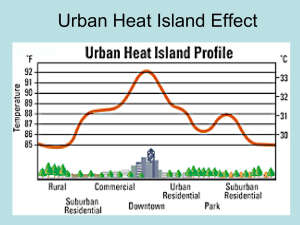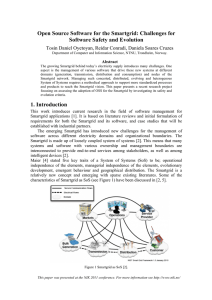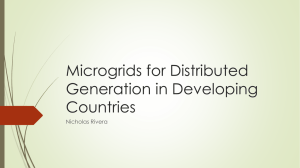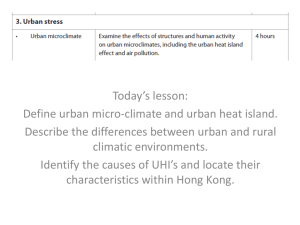island
advertisement
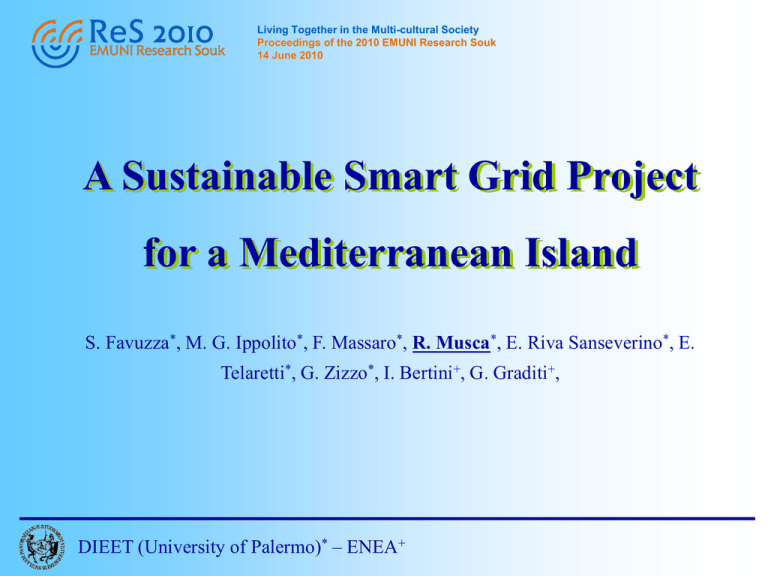
Living Together in the Multi-cultural Society Proceedings of the 2010 EMUNI Research Souk 14 June 2010 A Sustainable Smart Grid Project for a Mediterranean Island S. Favuzza*, M. G. Ippolito*, F. Massaro*, R. Musca*, E. Riva Sanseverino*, E. Telaretti*, G. Zizzo*, I. Bertini+, G. Graditi+, DIEET (University of Palermo)* – ENEA+ SmartGrid Definition The SmartGrid is a new concept of electrical network, which can intelligently integrate the actions of all users connected to it (generators, consumers, etc.) in order to efficiently deliver sustainable, economic and secure electricity supplies. A SmartGrid employs innovative products and services together with intelligent monitoring, control, communication and self-healing technologies. SmartGrid Concept Common hub Bulk generation Electric system SmartGrid Concept Smart meter Smart router Bulk generation SmartGrid Projects around the world EU: Microgrids: Large Scale Integration of Micro-Generation to Low Voltage Grids More Microgrids: Advanced Architectures and Control Concepts for More Microgrids USA: Consortium for Electric Reliability Technology Solutions (CERTS) JAPAN: Regional Power Grid with Renewable Energy Resources Project Projects around the world EU: Microgrids: Large Scale Integration of Micro-Generation to Low Voltage Grids; More Microgrids: Advanced Architectures and Control Concepts for More Microgrids The Kythnos Island Microgrid project provides a demonstration site where photovoltaic panels with diesel genset for back-up and battery banks as storage device serve twelve houses in a small microgrid structure, with the main goals of adaptation and installation of the agent-based software for centralized and de-centralized control. SmartGrid Project for a Mediterranean Island The SmartGrid project regards the evolution of the electrical distribution and generation system of a broad island having a central position in the Mediterranean sea: it is a feasibility study of the evolution towards the SmartGrid concept of the existing electrical system. SmartGrid Project for a Mediterranean Island The aim is to provide important changes in order to join new and alternative energy sources, reducing the traditional diesel generation, improve the island sustainability with waste treatment plant and electrical vehicles, increase intelligence and automation level, making the electrical system capable of dialogue and interaction with the needs of the various agents integrated within it. Energy System Actually, the island is totally dependent on the mainland. Diesel, petrol and liquefied petroleum gas (LPG) are imported regularly on the island. The project aims to reduce substantially this dependency. Energy System Solar energy (photovoltaic panels and thermal collectors) Wind turbine Geothermal power generation Waste treatment plant Power stations (electric vehicles) Energy System SOLAR ENERGY URBAN CENTER AIRPORT INDUSTRIAL AREA POWER PLANT WIND TURBINE WASTE TREATMENT POWER STATIONS GEOTHERMAL PLANT Energy System Scenario Coverage percentage of total energy needs Total energy production [GWh/year] Total reduction of CO2 emissions [103 kg/year] A 10% 4.32 3.3 B 50% 23.17 20.7 Different scenarios with coverage percentages of total energy needs and CO2 reduction Control System The originally centralized control of electrical system migrates towards a distributed intelligence, including a hierachical organization of different agents, featuring bidirectional controls and data flows, eventually allowing users to bargain in a deregulated energy market. INTEGRATION CENTRALIZED DISTRIBUTED AGENTS HIERARCHY BIDIRECTIONAL FLOWS Control System – Architecture The control system architecture of a SmartGrid must be flexible, expandable, to be opened to meet future needs. The Multiagent Platform (software agents) must have: autonomy, proactivity, social ability. Control System – Architecture MGCC The software agents are: MGCC (MicroGrid Central Controller) SC (Source Controller) SC LC LC (Load Controller) Distribution Management System (DMS) Control System – Communication technology The control system requires the adoption of telecommunications channels for data exchange between remote systems. In a generic communication system structure there are three main node types: the global network coordinator, the routers/coordinators and the end nodes. The designed architecture of SmartGrid control system can be of slave-master or multi-master type. Control System GLOBAL NETWORK COORDINATOR (MGCC – SC) ROUTER/COORDINATOR (SC) END NODE (LC) PHOTOVOLTAIC COMMUNICATION CHANNELS DIESEL POWER PLANT WIND TURBINE POWER STATION POWER STATION WASTE TREATMENT DESALATION PLANT GEOTHERMAL PLANT Control System – Communication technology At present, the island electric network has two redundant communication channels, one based on a radio technology, the other on GSM technology. The SmartGrid project can include other technologies for data transmission, based on power line communication (high costs for distribution system application) or wireless technologies (lower impact but significant problem of data security). Wi-Max is an interesting technology which has the possibility of covering large distances and mitigation of environmental impact. Conclusions The feasibility study of a SmartGrid project for a Mediterranean island poses a number of challenges and opportunities: the integration of new technologies and renewable sources in the existing system; the reduction of island dependency and of the pollution emissions; the increase of intelligence and automation level; the improving of system operation (power quality, minumum losses, etc.). Thank you for attention




